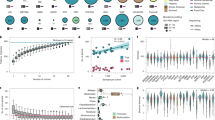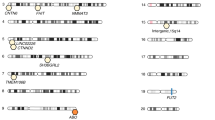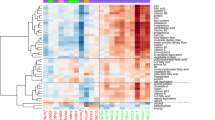Abstract
Intestinal microbiota is known to be important in health and disease. Its composition is influenced by both environmental and host factors. Few large-scale studies have evaluated the association between host genetic variation and the composition of microbiota. We recruited a cohort of 1,561 healthy individuals, of whom 270 belong in 123 families, and found that almost one-third of fecal bacterial taxa were heritable. In addition, we identified 58 SNPs associated with the relative abundance of 33 taxa in 1,098 discovery subjects. Among these, four loci were replicated in a second cohort of 463 subjects: rs62171178 (nearest gene UBR3) associated with Rikenellaceae, rs1394174 (CNTN6) associated with Faecalibacterium, rs59846192 (DMRTB1) associated with Lachnospira, and rs28473221 (SALL3) associated with Eubacterium. After correction for multiple testing, 6 of the 58 associations remained significant, one of which replicated. These results identify associations between specific genetic variants and the gut microbiome.
This is a preview of subscription content, access via your institution
Access options
Subscribe to this journal
Receive 12 print issues and online access
$209.00 per year
only $17.42 per issue
Buy this article
- Purchase on Springer Link
- Instant access to full article PDF
Prices may be subject to local taxes which are calculated during checkout



Similar content being viewed by others
Accession codes
References
Huse, S.M., Ye, Y., Zhou, Y. & Fodor, A.A. A core human microbiome as viewed through 16S rRNA sequence clusters. PLoS One 7, e34242 (2012).
Schloissnig, S. et al. Genomic variation landscape of the human gut microbiome. Nature 493, 45–50 (2013).
Jostins, L. et al. Host–microbe interactions have shaped the genetic architecture of inflammatory bowel disease. Nature 491, 119–124 (2012).
Welter, D. et al. The NHGRI GWAS Catalog, a curated resource of SNP–trait associations. Nucleic Acids Res. 42, D1001–D1006 (2014).
Gao, X., Starmer, J. & Martin, E.R. A multiple testing correction method for genetic association studies using correlated single nucleotide polymorphisms. Genet. Epidemiol. 32, 361–369 (2008).
Gao, X., Becker, L.C., Becker, D.M., Starmer, J.D. & Province, M.A. Avoiding the high Bonferroni penalty in genome-wide association studies. Genet. Epidemiol. 34, 100–105 (2010).
Goodrich, J.K. et al. Human genetics shape the gut microbiome. Cell 159, 789–799 (2014).
Qin, J. et al. A metagenome-wide association study of gut microbiota in type 2 diabetes. Nature 490, 55–60 (2012).
Karlsson, F.H. et al. Gut metagenome in European women with normal, impaired and diabetic glucose control. Nature 498, 99–103 (2013).
Davenport, E.R. et al. Genome-wide association studies of the human gut microbiota. PLoS One 10, e0140301 (2015).
Gevers, D. et al. The treatment-naive microbiome in new-onset Crohn's disease. Cell Host Microbe 15, 382–392 (2014).
Kevans, D. et al. IBD genetic risk profile in healthy first-degree relatives of Crohn's disease patients. J. Crohn's Colitis 10, 209–215 (2016).
Chanock, S.J. et al. Replicating genotype–phenotype associations. Nature 447, 655–660 (2007).
O'Toole, P.W. & Jeffery, I.B. Gut microbiota and aging. Science 350, 1214–1215 (2015).
Chang, Y.J. et al. Complete genome sequence of Acidaminococcus fermentans type strain (VR4). Stand. Genomic Sci. 3, 1–14 (2010).
GTEx Consortium. The Genotype-Tissue Expression (GTEx) Project. Nat. Genet. 45, 580–585 (2013).
Maller, J.B. et al. Bayesian refinement of association signals for 14 loci in 3 common diseases. Nat. Genet. 44, 1294–1301 (2012).
Liang, C. et al. Sjogren syndrome antigen B (SSB)/La promotes global microRNA expression by binding microRNA precursors through stem-loop recognition. J. Biol. Chem. 288, 723–736 (2013).
Jiang, X. & Chen, Z.J. The role of ubiquitylation in immune defence and pathogen evasion. Nat. Rev. Immunol. 12, 35–48 (2011).
Ashida, H., Kim, M. & Sasakawa, C. Exploitation of the host ubiquitin system by human bacterial pathogens. Nat. Rev. Microbiol. 12, 399–413 (2014).
Sokol, H. et al. Faecalibacterium prausnitzii is an anti-inflammatory commensal bacterium identified by gut microbiota analysis of Crohn disease patients. Proc. Natl. Acad. Sci. USA 105, 16731–16736 (2008).
Manichanh, C., Borruel, N., Casellas, F. & Guarner, F. The gut microbiota in IBD. Nat. Rev. Gastroenterol. Hepatol. 9, 599–608 (2012).
Turnbaugh, P.J. et al. A core gut microbiome in obese and lean twins. Nature 457, 480–484 (2009).
Spor, A., Koren, O. & Ley, R. Unravelling the effects of the environment and host genotype on the gut microbiome. Nat. Rev. Microbiol. 9, 279–290 (2011).
Thjodleifsson, B. et al. Subclinical intestinal inflammation: an inherited abnormality in Crohn's disease relatives? Gastroenterology 124, 1728–1737 (2003).
Human Microbiome Project Consortium. A framework for human microbiome research. Nature 486, 215–221 (2012).
Caporaso, J.G. et al. Ultra-high-throughput microbial community analysis on the Illumina HiSeq and MiSeq platforms. ISME J. 6, 1621–1624 (2012).
Masella, A.P., Bartram, A.K., Truszkowski, J.M., Brown, D.G. & Neufeld, J.D. PANDAseq: paired-end assembler for Illumina sequences. BMC Bioinformatics 13, 31 (2012).
Caporaso, J.G. et al. QIIME allows analysis of high-throughput community sequencing data. Nat. Methods 7, 335–336 (2010).
Edgar, R.C. Search and clustering orders of magnitude faster than BLAST. Bioinformatics 26, 2460–2461 (2010).
DeSantis, T.Z. et al. Greengenes, a chimera-checked 16S rRNA gene database and workbench compatible with ARB. Appl. Environ. Microbiol. 72, 5069–5072 (2006).
Langille, M.G. et al. Predictive functional profiling of microbial communities using 16S rRNA marker gene sequences. Nat. Biotechnol. 31, 814–821 (2013).
Paradis, E., Claude, J. & Strimmer, K. APE: Analyses of Phylogenetics and Evolution in R language. Bioinformatics 20, 289–290 (2004).
Tatusov, R.L., Koonin, E.V. & Lipman, D.J. A genomic perspective on protein families. Science 278, 631–637 (1997).
Li, J. & Ji, L. Adjusting multiple testing in multilocus analyses using the eigenvalues of a correlation matrix. Heredity (Edinb.) 95, 221–227 (2005).
Purcell, S. et al. PLINK: a tool set for whole-genome association and population-based linkage analyses. Am. J. Hum. Genet. 81, 559–575 (2007).
Howie, B.N., Donnelly, P. & Marchini, J. A flexible and accurate genotype imputation method for the next generation of genome-wide association studies. PLoS Genet. 5, e1000529 (2009).
Howie, B., Marchini, J. & Stephens, M. Genotype imputation with thousands of genomes. G3 (Bethesda) 1, 457–470 (2011).
Jia, X. et al. Imputing amino acid polymorphisms in human leukocyte antigens. PLoS One 8, e64683 (2013).
Almasy, L. & Blangero, J. Multipoint quantitative-trait linkage analysis in general pedigrees. Am. J. Hum. Genet. 62, 1198–1211 (1998).
Liang, K.-Y. & Zeger, S.L. Longitudinal data analysis using generalized linear models. Biometrika 73, 13–22 (1986).
Pan, W. Akaike's information criterion in generalized estimating equations. Biometrics 57, 120–125 (2001).
Giambartolomei, C. et al. Bayesian test for colocalisation between pairs of genetic association studies using summary statistics. PLoS Genet. 10, e1004383 (2014).
Acknowledgements
We thank the members of the GEM Global Project Office, C. Bravi, D. Couchman, N. Ganeswaren, A. Keludjian, K. Ow, R. Caplan, M. Greaves, A. Craig-Neil, A. Olteanu, N. Allam, A. Garrioch, D. Ng, V. Onay, and I. Yeadon, for administrative support. We thank D. Cvitkovitch for his helpful scientific discussion of the project. All authors disclose no potential conflicts (financial, professional, or personal) that are relevant to the manuscript. This study was supported by grants from Crohn's and Colitis Canada, Canadian Institutes of Health Research (CIHR) grant CMF108031 and the Helmsley Charitable Trust. W.T. is the recipient of a Postdoctoral Fellowship Research Award from CIHR Fellowship/Canadian Association of Gastroenterology (CAG)/Ferring Pharmaceuticals, Inc., and a fellowship from the Department of Medicine, Mount Sinai Hospital, Toronto. M.S.S. is supported in part by the Gale and Graham Wright Chair in Digestive Diseases. D.K. is the recipient of a CIHR/CAG/Abbvie IBD Fellowship Award. L.X. is the recipient of a CIHR STAGE fellowship. K.S. is the recipient of an Ontario Graduate Scholarship.
Author information
Authors and Affiliations
Consortia
Contributions
A.D.P. and K.C. contributed equally. A.D.P. and K.C. jointly supervised research. W.T., M.S.S., A.D.P., K.C., and the GEM Project Steering Committee conceived and designed the experiments. W.T., W.X., L.X., and K.C. performed the experiments. W.T., O.E.-G., W.X., L.X., and A.D.P. performed statistical analysis. W.T., M.S.S., M.I.S., W.X., G.M.-H., D.K., K.S., O.E.-G., D.S.G., L.X., A.D.P., and K.C. analyzed the data. W.X., L.X., A.D.P., A.G., R.P., A.O., and the GEM Project Consortium contributed reagents, materials, and/or analysis tools and contributed significant subject recruitment. W.T., A.D.P., and K.C. wrote the manuscript.
Corresponding authors
Ethics declarations
Competing interests
The authors declare no competing financial interests.
Supplementary information
Supplementary Text and Figures
Supplementary Figures 1–8 and Supplementary Note. (PDF 3576 kb)
Supplementary Table 1
Geographic origin of individuals in the discovery and replication cohorts. (XLSX 18 kb)
Supplementary Table 2
Heritability assessment of bacterial taxa, choa1, Shannon PD whole-tree α diversity index, and microbial dysbiosis index in 123 independent families. (XLSX 42 kb)
Supplementary Table 3
P values of association of the bacterial α diversity measure with SNPs in the discovery cohort. (XLS 102 kb)
Supplementary Table 4
P values of association of SNPs with the bacterial microbial dysbiosis index in the discovery cohort. (XLSX 18 kb)
Supplementary Table 5
P values of association of the bacterial taxa with 123 IBD-related SNPs in the discovery cohort. (XLS 10046 kb)
Supplementary Table 6
Significant genome-wide associated taxa. (XLSX 55 kb)
Supplementary Table 7
Results of colocalization analysis of rs62171178 with Rikenellaceae relative abundance and PHOSPHO2 expression in the stomach. (XLSX 222 kb)
Supplementary Table 8
P values for association of bacterial COG function with rs62171178. (XLSX 530 kb)
Rights and permissions
About this article
Cite this article
Turpin, W., Espin-Garcia, O., Xu, W. et al. Association of host genome with intestinal microbial composition in a large healthy cohort. Nat Genet 48, 1413–1417 (2016). https://doi.org/10.1038/ng.3693
Received:
Accepted:
Published:
Issue Date:
DOI: https://doi.org/10.1038/ng.3693
This article is cited by
-
Human genetic associations of the airway microbiome in chronic obstructive pulmonary disease
Respiratory Research (2024)
-
Host genetic regulation of human gut microbial structural variation
Nature (2024)
-
Effects of OsomeFood Clean Label plant-based meals on the gut microbiome
BMC Microbiology (2023)
-
Mechanistic Insights into Immune-Microbiota Interactions and Preventive Role of Probiotics Against Autoimmune Diabetes Mellitus
Probiotics and Antimicrobial Proteins (2023)
-
Genetic mapping of microbial and host traits reveals production of immunomodulatory lipids by Akkermansia muciniphila in the murine gut
Nature Microbiology (2023)



